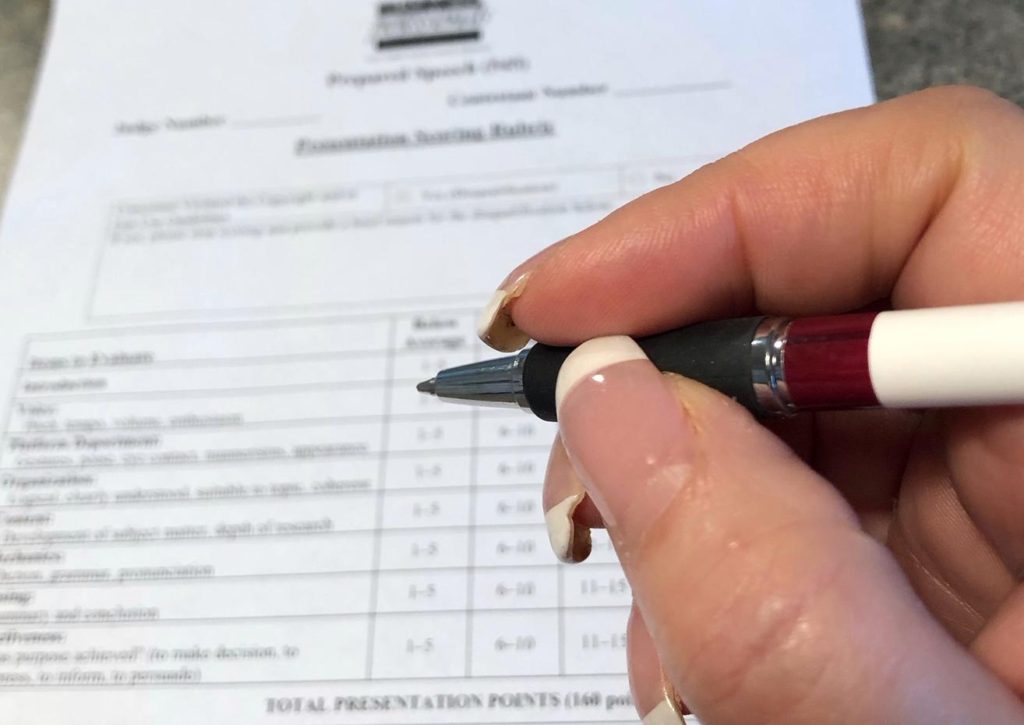What can you learn about public speaking skills from high school students?
A lot, if you pay attention!
Today, I had to pay attention as 7 high school students each stood before me and spoke for 5-7 minutes in the Prepared Speech category in a regional competition of the Business Professionals of America. I was to judge them on a 160-point scoring rubric that included categories such as Voice, Platform Deportment, Organization, etc. I was impressed with their poise, their research and their preparation!
Here are the top 8 lessons that we all can use based on my observations today:
- Eye contact matters. A lot. Only one student had no notes. She was the most compelling speaker (although she ended up in 2nd place by one point). Several students had good eye contact, but still occasionally read from their note cards. One student almost never made eye contact, but instead looked at random places in the room when not reading from his note cards. Even though I was one of only two people in the audience, that student never did engage with me. If you use notes, follow the rule, “talk to people, not to paper.” This means that it is OK to glance down at your notes, but then look up and make eye contact before you speak. Using brief keyword notes can facilitate this technique.
- Props/visuals can be distracting. If they don’t clearly enhance the presentation, they are just cognitive “noise.” Of the 7 students, 5 used easels with poster board visuals. In all but one of those, I was distracted because:
- The visual was too busy or too decorative. I started thinking things like, “Oh, that was a clever use of patterned origami paper.”
- The transition from one visual to another was clumsy (in one case, the visual fell off the easel).
- For one speech, because I was studying a visual with several numbers on it, I wasn’t listening to the speaker. People aren’t adept at reading and listening at the same time. In fact, you annoy your audience if you speak while they are reading.
- The small amount of time to set up the visual (the students had up to one minute to set up props), did detract slightly from a strong opening.
- Be very clear on your point, and make only ONE main point in a short speech. Your point will be more memorable and your audience less confused. Of the 7 speeches, 6 hours later I can only remember 3 of the topics clearly.
- Don’t cram content. A few students spoke at a quick pace, in part to stay within time limits. They didn’t pause enough to allow points to hit home.
- Make sure you pronounce names/words correctly. I almost laughed out loud when a student pronounced Warren Buffett’s last name as “buf-fay” (like the self-service buffet meal). When you have a prepared speech, there is no excuse for not checking on pronunciation. The student could have simply googled “Warren Buffett pronunciation.”
- Use relevant stories/personal connection to the topic. Stories and personal connection to the topic make it MUCH more interesting for the audience, and it makes you more credible on the topic. Otherwise, your audience wonders, “Why do you care about this topic?” However, the connection/story should relate to the topic! One student talked about the stress of being so busy and then segued into a speech on a completely different topic.
- Tell or show me why I should care. In the most effective opening of all of the speeches, the speaker opened her speech by asking the audience to imagine a successful executive and then gave us a few moments to form a mental image. She then said something like, “I bet that the person you imagined was white.” Yep. I had imagined an older white man. She, a young black woman, then went on to talk about implicit racism in the workplace.
- Dressing well makes a good first impression. All 7 students dressed professionally, but one male student’s tie was off to the side so that his shirt buttons were showing. A quick trip to the restroom for a final check would have eliminated that problem.
Apply these lessons to your next presentation to engage your audience and get you and your message remembered!

